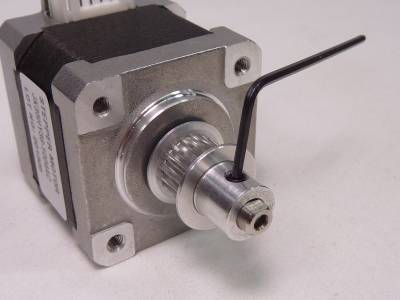This is an old revision of the document!
Layer Shifting
 Layer shifting is a problem occurring with some A5 and A3S printers. While there are several root causes, this printing defect occurs whenever the printing head, or printing bed, are shifted, without the controller being aware. The printing process is an open-loop control system, so there is no way for the controller to know that something has gone wrong.
Layer shifting is a problem occurring with some A5 and A3S printers. While there are several root causes, this printing defect occurs whenever the printing head, or printing bed, are shifted, without the controller being aware. The printing process is an open-loop control system, so there is no way for the controller to know that something has gone wrong.
Under normal operation during printing, the stepper motors maintain control of the x, y and z axis position at all times. The stepper motor generally has sufficient power to overcome any minor resistance forces like friction and inertia, and if you push lightly on the printing head or bed while printing, the printer should be able to resist your forces.
However, if a force is applied that exceeds the grip strength of the motor, the motor's control will be overcome. When this happens, a layer shift may occur.
There are several possible causes for a layer shift:
Poorly tuned Stepper Drivers
Out of the box, some A5 and A3S printers have been delivered with untuned stepper drivers. The stepper drivers are the chips that are responsible for powering each of the motors. These stepper drivers have a small adjustable potentiometer that sets how much current is delivered to each motor. Too much current, and the stepper driver may overheat – when this happens the driver may briefly turn off to enable it to cool down, and this may result in a layer shift. Too little current, and the small resistance forces that occur during printing may overcome the motor, and a layer shift may occur. For more information on how to properly tune your drivers, see this page.
Loose Pulley Grub Screws
 The motor shafts transmit power to the timing belts through toothed gears, known as pulleys. These pulleys are fixed onto the motor shaft by a very small screw, known as a grub screw. If the grub screw is not tightened, this may cause the pulley to slip on the motor shaft. This can cause a layer shift.
The motor shafts transmit power to the timing belts through toothed gears, known as pulleys. These pulleys are fixed onto the motor shaft by a very small screw, known as a grub screw. If the grub screw is not tightened, this may cause the pulley to slip on the motor shaft. This can cause a layer shift.
Loose Belts
If the belts on the A5 are not tightened sufficiently, they may be able to slip on the pulley. This can cause a layer shift. The belts on the printer should be able to be plucked like a string, and you should hear a mid/low pitched note. Tightening the belts on the A5 is not easy. The best suggestion has been a four step process:
- Work out how much the belt needs to be tightened
- Slide the belt off one of the motor pulleys
- Adjust the belt accordingly while it is loose
- Slide the belt back over the motor pulley again
Bad Bearings
The bearings on the A5 are not high quality. The Y axis bearings may become stuck from time to time, and this can cause a layer shift. Replacing a bearing on the A5 is a long process, and there is no video or documentation for this process yet. Several members have replaced the ball bearings with IGUS linear bushings. Another good alternative for replacing the ball bearings are brass bushings with graphite lubricant.
Printing too fast!
If your printing settings are too fast, you may exceed the ability of the motors to maintain the position accurately. This can be simply the printing max speed is too high, or the acceleration or jerk settings are too aggressive.


